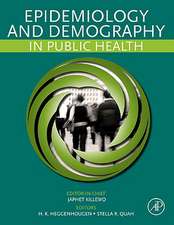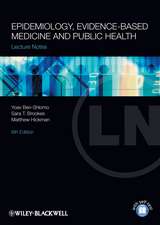Permutation Statistical Methods: An Integrated Approach
Autor Kenneth J. Berry, Paul W. Mielke, Jr., Janis E. Johnstonen Limba Engleză Hardback – 13 mai 2016
Permutation statistical methods, compared to classical statistical methods, do not rely on theoretical distributions, avoid the usual assumptions of normality and homogeneity of variance, and depend only on the data at hand. This text takes a unique approach to explaining statistics by integrating a large variety of statistical methods, and establishing the rigor of a topic that to many may seem to be a nascent field in statistics. This topic is new in that it took modern computing power to make permutation methods available to people working in the mainstream of research.
lly-informed="" audience,="" and="" can="" also="" easily="" serve="" as="" textbook="" in="" graduate="" course="" departments="" such="" statistics,="" psychology,="" or="" biology.="" particular,="" the="" audience="" for="" book="" is="" teachers="" of="" practicing="" statisticians,="" applied="" quantitative="" students="" fields="" medical="" research,="" epidemiology,="" public="" health,="" biology.
| Toate formatele și edițiile | Preț | Express |
|---|---|---|
| Paperback (1) | 657.39 lei 6-8 săpt. | |
| Springer International Publishing – 27 mai 2018 | 657.39 lei 6-8 săpt. | |
| Hardback (1) | 663.93 lei 6-8 săpt. | |
| Springer International Publishing – 13 mai 2016 | 663.93 lei 6-8 săpt. |
Preț: 663.93 lei
Preț vechi: 781.08 lei
-15% Nou
Puncte Express: 996
Preț estimativ în valută:
127.04€ • 132.38$ • 105.19£
127.04€ • 132.38$ • 105.19£
Carte tipărită la comandă
Livrare economică 03-17 aprilie
Preluare comenzi: 021 569.72.76
Specificații
ISBN-13: 9783319287683
ISBN-10: 3319287680
Pagini: 533
Ilustrații: XX, 622 p. 180 illus.
Dimensiuni: 155 x 235 x 41 mm
Greutate: 1.07 kg
Ediția:1st ed. 2016
Editura: Springer International Publishing
Colecția Springer
Locul publicării:Cham, Switzerland
ISBN-10: 3319287680
Pagini: 533
Ilustrații: XX, 622 p. 180 illus.
Dimensiuni: 155 x 235 x 41 mm
Greutate: 1.07 kg
Ediția:1st ed. 2016
Editura: Springer International Publishing
Colecția Springer
Locul publicării:Cham, Switzerland
Public țintă
ResearchCuprins
Preface.- 1.Introduction.- 2.Completely Randomized Data.- 3.Randomized Designs: Interval Data.- 4.Regression Analysis of Interval Data.- 5.Randomized Designs: Ordinal Data, I.- 6.Randomized Designs: Ordinal Data, II.- 7.Randomized Designs: Nominal Data.- 8.Randomized Designs: Nominal Data.- 9.Randomized Block Designs: Interval Data.- 10.Randomized Block Designs: Ordinal Data.- 11.Randomized Block Designs: Nominal Data.- Epilogue.- References.- Author Index.- Subject Index.
Recenzii
“This book summarizes the applications of the MRPP done by the authors to various statistical problems … . This book may be useful for researchers who are interested in extending the MRPP to other types of data and statistical problems, for example, survival data with possible censoring of observations.” (Dongsheng Tu, zbMATH 1358.62011, 2017)
Textul de pe ultima copertă
This research monograph provides a synthesis of a number of statistical tests and measures, which, at first consideration, appear disjoint and unrelated. Numerous comparisons of permutation and classical statistical methods are presented, and the two methods are compared via probability values and, where appropriate, measures of effect size.
Permutation statistical methods, compared to classical statistical methods, do not rely on theoretical distributions, avoid the usual assumptions of normality and homogeneity of variance, and depend only on the data at hand. This text takes a unique approach to explaining statistics by integrating a large variety of statistical methods, and establishing the rigor of a topic that to many may seem to be a nascent field in statistics. This topic is new in that it took modern computing power to make permutation methods available to people working in the mainstream of research. This research monograph addresses a statistically-informed audience, and can also easily serve as a textbook in a graduate course in departments such as statistics, psychology, or biology. In particular, the audience for the book is teachers of statistics, practicing statisticians, applied statisticians, and quantitative graduate students in fields such as psychology, medical research, epidemiology, public health, and biology.
Permutation statistical methods, compared to classical statistical methods, do not rely on theoretical distributions, avoid the usual assumptions of normality and homogeneity of variance, and depend only on the data at hand. This text takes a unique approach to explaining statistics by integrating a large variety of statistical methods, and establishing the rigor of a topic that to many may seem to be a nascent field in statistics. This topic is new in that it took modern computing power to make permutation methods available to people working in the mainstream of research. This research monograph addresses a statistically-informed audience, and can also easily serve as a textbook in a graduate course in departments such as statistics, psychology, or biology. In particular, the audience for the book is teachers of statistics, practicing statisticians, applied statisticians, and quantitative graduate students in fields such as psychology, medical research, epidemiology, public health, and biology.
Caracteristici
Presents a methodological umbrella under which (1) disparate statistical methods are synthesized and integrated and (2) a number of new permutation statistical methods are developed Synthesizes and integrates a large number of existing classical statistics under a common mathematical function Provides computing algorithms for calculating permutation tests, and details the history of permutation statistical methods












